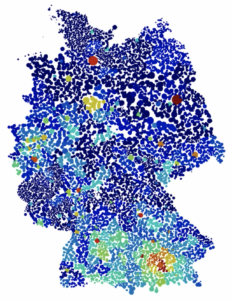Modelling with spatial resolution
COVID-19 modelling with spatial resolution
 The COVID-19 pandemic has kept the world in suspense for the last months, but the strict curfews and containment rules are slowly being lifted in most countries. Germany has just eased their regulations and public life is finding its way back to a new normality. Being a federal country, its states now have the authority to decide on their way forward. However, to reliably predict the effect of such political decisions and locally monitor the spread of the disease, spatially resolved models are of essence. Here, we introduce a new SI2RD model to a) approach dark figures of the overall number of infections, b) spatio-temporally resolve the evolution of the pandemic on a county level, and c) account for the effect of political decisions on the spread of the disease. We identify optimal parameter sets that well fit data on cumulative infections and deaths from the Robert-Koch Institute (RKI), and observe trends on the most effective containment rules. We believe that our model may help guide decision makers on a state or even community politics level to individually strategize their best way forward based on local outbreak dynamics.
The COVID-19 pandemic has kept the world in suspense for the last months, but the strict curfews and containment rules are slowly being lifted in most countries. Germany has just eased their regulations and public life is finding its way back to a new normality. Being a federal country, its states now have the authority to decide on their way forward. However, to reliably predict the effect of such political decisions and locally monitor the spread of the disease, spatially resolved models are of essence. Here, we introduce a new SI2RD model to a) approach dark figures of the overall number of infections, b) spatio-temporally resolve the evolution of the pandemic on a county level, and c) account for the effect of political decisions on the spread of the disease. We identify optimal parameter sets that well fit data on cumulative infections and deaths from the Robert-Koch Institute (RKI), and observe trends on the most effective containment rules. We believe that our model may help guide decision makers on a state or even community politics level to individually strategize their best way forward based on local outbreak dynamics.Silvia Budday, Christian Burkhardt, Andreas Kergassner, Paul Steinmann
